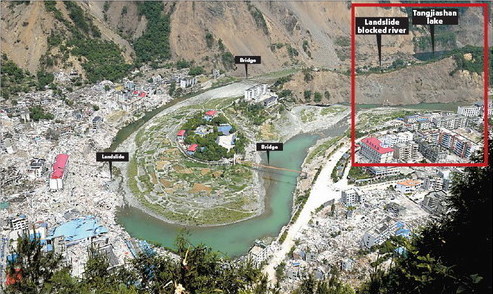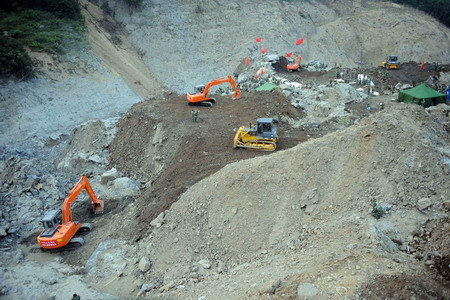More than 150,000 people who face the threat of flooding should a quake lake near Beichuan bursts its banks were evacuated last night even as engineers were digging a diversion channel to prevent flooding.

An aerial view of Tangjiashan lake (in red box) near Beichuan county May 27, 2008. Troops were digging a diversion channel to prevent the lake from bursting its banks and threatening more misery to millions of people downstream.
Local authorities said they evacuated 158,000 people by midnight Tuesday in case Tangjiashan lake - formed when landslides blocked Jianjiang River after the May 12 quake - overflows its banks.
According to contingency plans, up to 1.3 million people from 33 townships of Mianyang city could be relocated if the lake barrier collapsed entirely.
Premier Wen Jiabao told a meeting of the State Council quake relief headquarters Tuesday that handling the quake lakes is the "most pressing" task at present.
The water level in the Tangjiashan lake has kept rising and the water diversion channel won't be effective till June 5, experts said Tuesday.
Tangjiashan lake was holding 130 million cu m of water - or the volume of water in about 50,000 Olympic-size swimming pools - said Liu Ning, chief engineer of the Ministry of Water Resources who was at the site to oversee the diversion work.
More than 600 engineers and soldiers were working nonstop at the lake site to dig the channel.
Cai Qihua, of the Yangtze River Water Resources Commission, said 26 excavators and bulldozers were being used around the clock.
The water is rising by nearly 2 m a day and reached only 23 m below the lowest part of the barrier Tuesday, she said.
Many towns and villages downstream held evacuation drills Tuesday.
In Tianlin village, among the first to be flooded if the lake bursts, gongs and loudspeakers directed 680 villagers to rush to surrounding hills within 20 minutes.
"The flood will sweep our village in 5 or 6 hours if the dam collapses," the village head said.

Diggers, including PLA soldiers and armed police, use excavators and bulldozers to dig a diversion channel for a quake lake at Tangjiashan, Beichuan County, which was formed by landslides after the May 12 earthquake and now blocks the river Jianhe on May 26, 2008. Helicopters have airlifted professionals and materials for the operation to the area Monday afternoon.
Jianjiang River runs into Fujiang River about 10 km north of the village.
Compounding flood fears, two fresh aftershocks struck quake-hit areas Tuesday.
A 5.7-magnitude aftershock struck Ningqiang county of Shaanxi province Tuesday at 4:37 pm. It was also felt in the provincial capital of Xi'an.
Earlier, at 4:03 pm, a 5.4-magnitude aftershock hit Qingchuan county in Sichuan, which is very close to Ningqiang,
The two aftershocks were also felt in the Sichuan provincial capital Chengdu and parts of Chongqing and Gansu.
More than 60 people were injured and 420,000 houses in Qingchuan collapsed in the aftershocks.
Qingchuan was the epicenter of a 6.4-magnitude aftershock on Sunday afternoon, which was the strongest aftershock since May 12.
The death toll from the quake reached 67,183 by midday Tuesday, with 361,822 injured and 20,790 missing, according to the Information Office of the State Council.
More than 45.61 million people were affected in the deadly quake, and about 15 million have been displaced, according to the office.
By noon Tuesday, donations in cash and relief materials from home and abroad reached 32.7 billion yuan ($4.7 billion). So far, 9.4 billion yuan ($1.35 billion) has been forwarded to the quake-affected areas, the office said.
Meanwhile, 566,400 tents had been sent to quake-affected areas by noon Tuesday, according to the Ministry of Civil Affairs.
(China Daily, Xinhua News Agency May 28, 2008)